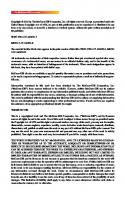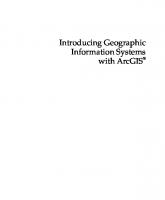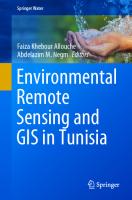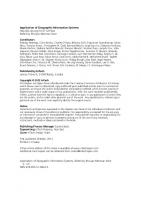Environmental Modelling with GIS and Remote Sensing (Geographic Information Systems Workshop) [1 ed.] 9780415241700, 0415241707
This is not a lite reading book. It is however and excellent reference book one that I highly recommend for anyone'
460 49 433KB
English Pages 275 Year 2002
Table of contents :
Environmental Modelling with GIs and Remote Sensing......Page 1
Contents......Page 3
Preface......Page 9
List of Figures......Page 11
List of Tables and Boxes......Page 15
1.1 THE CHALLENGE......Page 17
Contents ......Page 0
1.2 MOTIVATION TO WRITE THIS BOOK......Page 18
1.3 WHAT IS ENVIRONMENTAL MODELLING AND HOW CAN GIS AND REMOTE SENSING HELP IN ENVIRONMENTAL MODELLING? ......Page 19
1.4 CONTENTS OF THE BOOK......Page 22
1.5 REFERENCES......Page 23
2.1 INTRODUCTION......Page 24
2.2 TAXONOMY OF MODELS......Page 25
2.3.1 Deductive models......Page 26
2.3.2 Inductive models......Page 27
2.3.3 Discussion......Page 30
2.4.1 Empirical models......Page 31
2.4.2 Knowledge driven models......Page 34
2.4.3 Process driven models......Page 36
2.5 STOCHASTIC MODELS......Page 37
2.7 REFERENCES......Page 39
3.1 INTRODUCTION......Page 42
3.2.1 Historical overview......Page 43
3.2.3 IRS-1C and IRS-1D......Page 44
3.2.6 Ikonos......Page 45
3.2.8 Eros......Page 46
3.3.1 Historical overview......Page 47
3.3.2.2 EOS-AM 1 ......Page 49
3.3.2.4 EO-1 ......Page 50
3.3.3 Applications and perspectives......Page 51
3.4.1.2 NOAA......Page 52
3.4.1.3 Resurs-01 ......Page 53
3.4.2 Medium spatial resolution satellite systems with high revisiting time......Page 54
3.4.2.1 Landsat ......Page 55
3.4.2.2 SPOT 1/2/3 (Systkme Pour I'Obsewation de la Terre)......Page 56
3.5.1 Historical overview......Page 57
3.5.2.1 ERS-1 and 2......Page 59
3.5.2.3 Envisat......Page 60
3.5.2.5 JERS-1 ......Page 61
3.5.3 Applications and perspectives......Page 62
3.6.3 Lidar......Page 63
3.7.4 RADAR satellite systems......Page 64
3.8 REFERENCES......Page 65
4.1 INTRODUCTION......Page 68
4.3 ECOSYSTEMS PROCESS MODELLING......Page 70
4.5 DYNAMIC BIOSPHERE MODELLING......Page 71
4.6 DATA ACCESS......Page 72
4.7.1 Multiple-theme global databases......Page 73
4.7.2 Heritage global land cover databases......Page 74
4.7.3 Global land cover from satellite data......Page 75
4.7.4 Topographic data......Page 76
4.7.7 Satellite data......Page 77
4.8.1 Regional land cover mapping......Page 78
4.8.3 Administrative and census data......Page 79
4.8.4 Data clearinghouses......Page 80
4.9 THE ROLE OF THE END-USER IN THE USGS GLOBAL LAND COVER CHARACTERIZATION PROJECT......Page 81
4.10 SUMMARY......Page 82
4.11 REFERENCES......Page 83
5.1 INTRODUCTION......Page 86
5.2 HISTORIC OVERVIEW......Page 87
5.3 LANDSAT BASED REGIONAL STUDIES......Page 89
5.3.1 The Large Area Crop Inventory Program......Page 90
5.3.2 Tropical deforestation and habitat fragmentation......Page 91
5.4.1 Sources of interference......Page 92
5.4.1.1 Sensor degradation......Page 93
5.4.1.3 Clouds......Page 94
5.4.1.4 Solar zenith angle effects......Page 95
5.4.2 Desert margin studies......Page 96
5.4.3 Monitoring Desert Locust habitats......Page 98
5.4.4 Land cover classification......Page 100
5.4.5 ENSO ......Page 102
5.5 WILD FIRE DETECTION......Page 104
5.7 REFERENCES......Page 105
6.1 INTRODUCTION......Page 113
6.2.1 Historical overview......Page 114
6.2.2 Multispectral data and image classification......Page 115
6.2.3 Vegetation mapping, ancillary data and GIs......Page 116
Introduction......Page 117
Solar radiation data......Page 118
Results......Page 119
Possible uses of irzsolation data in forestry rnodellirzg......Page 122
6.2.4 Use of spatial and temporal patterns......Page 123
6.2.5.1 Hyperspectral imagery......Page 125
6.2.6 Accuracy assessment......Page 127
6.3.1 Monitoring vegetation condition and health......Page 129
6.3.1.2 Multitemporal analysis......Page 130
6.3.2 Vegetation conversion and change......Page 131
6.5 REFERENCES......Page 132
7.1 INTRODUCTION......Page 137
7.2 WILDLIFE CONSERVATION AND RESERVE MANAGEMENT......Page 138
7.3 MAPPING WILDLIFE DISTRIBUTION......Page 139
7.4 MAPPING WILDLIFE RESOURCE REQUIREMENTS......Page 141
7.5.1 Habitats and habitat maps......Page 142
7.5.2 Mapping suitability for wildlife......Page 143
7.5.3 Accuracy of suitability maps......Page 144
7.5.4 Factors influencing wildlife distribution......Page 146
7.6 MODELLING SPECIES-ENVIRONMENT RELATIONSHIPS......Page 147
7.6.1 Static versus dynamic models......Page 149
7.7 INNOVATIVE MAPPING OF WILDLIFE AND ITS PHYSICAL ENVIRONMENT......Page 151
7.8 CONCLUSIONS......Page 152
7.9 REFERENCES......Page 153
8.2 DEFINITIONS......Page 161
8.3 KEY ISSUES......Page 162
8.4.1 Attribute selection......Page 163
8.4.3 Data capture......Page 164
8.4.4 Standards and quality assurance......Page 165
8.4.5 Data custodianship and access......Page 167
8.5 TOOLS AND TECHNIQUES......Page 168
8.5.2.1 Rasterdata......Page 170
8.5.3.1 Where does a species occur?......Page 171
8.5.4 Environmental domain analysis......Page 173
8.5.5 Environmental assessment and decision support......Page 174
8.6 DISPLAY AND COMMUNICATION......Page 175
8.8 REFERENCES AND INFORMATION RESOURCES......Page 176
8.9 TOOLS AND TECHNOLOGIES ......Page 179
9.1 BASIC HYDROLOGICAL PROCESSES AND MODELLING APPROACHES......Page 182
9.1.1 The hydrological cycle......Page 183
9.1.2 Modelling approaches......Page 188
9.2 DATA FOR SPATIALLY DISTRIBUTED HYDROLOGICAL MODELLING......Page 189
9.2.1 Vegetation......Page 190
9.2.2 Modelling vegetation growth......Page 194
9.2.3 Topography......Page 195
9.2.4 Soil......Page 197
9.2.5 Climate......Page 198
9.3.1 Estimation of potential evaporation......Page 200
9.3.2 Estimation of actual evaporation and evapotranspiration......Page 203
9.4 THE DISTRIBUTION OF SURFACE FLOW IN DIGITAL ELEVATION MODELS......Page 205
9.4.1 Estimation of topographic form for 'undisturbed' surface facets......Page 208
9.5 ESTIMATION OF SUBSURFACE FLOW......Page 209
9.5.1 Estimation of subsurface unsaturated flow......Page 210
9.6 SUMMARY......Page 211
9.7 REFERENCES......Page 212
10.1 INTRODUCTION......Page 216
10.2 DISASTER MANAGEMENT......Page 222
10.3.1 Introduction......Page 223
10.3.2.1 National level......Page 224
10.3.2.3 Medium level......Page 225
10.4.1 Floods......Page 226
10.4.2 Earthquakes......Page 228
10.4.3 Volcanic eruptions......Page 231
10.4.4 Landslides......Page 233
10.4.5.1 Wildfire......Page 234
10.4.6 Cyclones......Page 235
10.4.7 Environmental hazards......Page 236
10.5 CONCLUSIONS......Page 237
10.6 REFERENCES......Page 238
11.1 INTRODUCTION......Page 243
11.2 GIs IN LAND USE PLANNING ACTIVITIES......Page 245
11.3.1 Land topography......Page 246
11.3.2 Soils......Page 247
11.3.3 Land uselcover......Page 248
11.4.1.1 Soil management groupings......Page 250
11.4.1.2 Soil productivity ratings and indices......Page 251
11.4.2 Quantitative approaches......Page 252
11.4.4 Standard land evaluation systems......Page 254
11.5 LAND USE PLANNING ACTIVITIES AT REGIONAL AND GLOBAL SCALES......Page 255
11.6 AVAILABILITY AND DISTRIBUTION OF SPATIAL DATA SETS......Page 258
11.7 RELIABILITY OF GIs-BASED LAND USE PLANNING RESULTS......Page 259
11.8 SUMMARY AND CONCLUSIONS......Page 260
11.9 REFERENCES......Page 261
12.2 GEO-INFORMATION RELATED QUESTIONS ENVIRONMENTAL MANAGEMENT......Page 268
12.3.1 Data problems......Page 270
12.3.3 GIS and remote sensing technology problems......Page 271
12.4.1 Data solutions......Page 272
12.4.3 GIs and RS technology solutions......Page 273
12.5 REFLECTION......Page 274
12.6 REFERENCES......Page 275
Environmental Modelling with GIs and Remote Sensing......Page 1
Contents......Page 3
Preface......Page 9
List of Figures......Page 11
List of Tables and Boxes......Page 15
1.1 THE CHALLENGE......Page 17
Contents ......Page 0
1.2 MOTIVATION TO WRITE THIS BOOK......Page 18
1.3 WHAT IS ENVIRONMENTAL MODELLING AND HOW CAN GIS AND REMOTE SENSING HELP IN ENVIRONMENTAL MODELLING? ......Page 19
1.4 CONTENTS OF THE BOOK......Page 22
1.5 REFERENCES......Page 23
2.1 INTRODUCTION......Page 24
2.2 TAXONOMY OF MODELS......Page 25
2.3.1 Deductive models......Page 26
2.3.2 Inductive models......Page 27
2.3.3 Discussion......Page 30
2.4.1 Empirical models......Page 31
2.4.2 Knowledge driven models......Page 34
2.4.3 Process driven models......Page 36
2.5 STOCHASTIC MODELS......Page 37
2.7 REFERENCES......Page 39
3.1 INTRODUCTION......Page 42
3.2.1 Historical overview......Page 43
3.2.3 IRS-1C and IRS-1D......Page 44
3.2.6 Ikonos......Page 45
3.2.8 Eros......Page 46
3.3.1 Historical overview......Page 47
3.3.2.2 EOS-AM 1 ......Page 49
3.3.2.4 EO-1 ......Page 50
3.3.3 Applications and perspectives......Page 51
3.4.1.2 NOAA......Page 52
3.4.1.3 Resurs-01 ......Page 53
3.4.2 Medium spatial resolution satellite systems with high revisiting time......Page 54
3.4.2.1 Landsat ......Page 55
3.4.2.2 SPOT 1/2/3 (Systkme Pour I'Obsewation de la Terre)......Page 56
3.5.1 Historical overview......Page 57
3.5.2.1 ERS-1 and 2......Page 59
3.5.2.3 Envisat......Page 60
3.5.2.5 JERS-1 ......Page 61
3.5.3 Applications and perspectives......Page 62
3.6.3 Lidar......Page 63
3.7.4 RADAR satellite systems......Page 64
3.8 REFERENCES......Page 65
4.1 INTRODUCTION......Page 68
4.3 ECOSYSTEMS PROCESS MODELLING......Page 70
4.5 DYNAMIC BIOSPHERE MODELLING......Page 71
4.6 DATA ACCESS......Page 72
4.7.1 Multiple-theme global databases......Page 73
4.7.2 Heritage global land cover databases......Page 74
4.7.3 Global land cover from satellite data......Page 75
4.7.4 Topographic data......Page 76
4.7.7 Satellite data......Page 77
4.8.1 Regional land cover mapping......Page 78
4.8.3 Administrative and census data......Page 79
4.8.4 Data clearinghouses......Page 80
4.9 THE ROLE OF THE END-USER IN THE USGS GLOBAL LAND COVER CHARACTERIZATION PROJECT......Page 81
4.10 SUMMARY......Page 82
4.11 REFERENCES......Page 83
5.1 INTRODUCTION......Page 86
5.2 HISTORIC OVERVIEW......Page 87
5.3 LANDSAT BASED REGIONAL STUDIES......Page 89
5.3.1 The Large Area Crop Inventory Program......Page 90
5.3.2 Tropical deforestation and habitat fragmentation......Page 91
5.4.1 Sources of interference......Page 92
5.4.1.1 Sensor degradation......Page 93
5.4.1.3 Clouds......Page 94
5.4.1.4 Solar zenith angle effects......Page 95
5.4.2 Desert margin studies......Page 96
5.4.3 Monitoring Desert Locust habitats......Page 98
5.4.4 Land cover classification......Page 100
5.4.5 ENSO ......Page 102
5.5 WILD FIRE DETECTION......Page 104
5.7 REFERENCES......Page 105
6.1 INTRODUCTION......Page 113
6.2.1 Historical overview......Page 114
6.2.2 Multispectral data and image classification......Page 115
6.2.3 Vegetation mapping, ancillary data and GIs......Page 116
Introduction......Page 117
Solar radiation data......Page 118
Results......Page 119
Possible uses of irzsolation data in forestry rnodellirzg......Page 122
6.2.4 Use of spatial and temporal patterns......Page 123
6.2.5.1 Hyperspectral imagery......Page 125
6.2.6 Accuracy assessment......Page 127
6.3.1 Monitoring vegetation condition and health......Page 129
6.3.1.2 Multitemporal analysis......Page 130
6.3.2 Vegetation conversion and change......Page 131
6.5 REFERENCES......Page 132
7.1 INTRODUCTION......Page 137
7.2 WILDLIFE CONSERVATION AND RESERVE MANAGEMENT......Page 138
7.3 MAPPING WILDLIFE DISTRIBUTION......Page 139
7.4 MAPPING WILDLIFE RESOURCE REQUIREMENTS......Page 141
7.5.1 Habitats and habitat maps......Page 142
7.5.2 Mapping suitability for wildlife......Page 143
7.5.3 Accuracy of suitability maps......Page 144
7.5.4 Factors influencing wildlife distribution......Page 146
7.6 MODELLING SPECIES-ENVIRONMENT RELATIONSHIPS......Page 147
7.6.1 Static versus dynamic models......Page 149
7.7 INNOVATIVE MAPPING OF WILDLIFE AND ITS PHYSICAL ENVIRONMENT......Page 151
7.8 CONCLUSIONS......Page 152
7.9 REFERENCES......Page 153
8.2 DEFINITIONS......Page 161
8.3 KEY ISSUES......Page 162
8.4.1 Attribute selection......Page 163
8.4.3 Data capture......Page 164
8.4.4 Standards and quality assurance......Page 165
8.4.5 Data custodianship and access......Page 167
8.5 TOOLS AND TECHNIQUES......Page 168
8.5.2.1 Rasterdata......Page 170
8.5.3.1 Where does a species occur?......Page 171
8.5.4 Environmental domain analysis......Page 173
8.5.5 Environmental assessment and decision support......Page 174
8.6 DISPLAY AND COMMUNICATION......Page 175
8.8 REFERENCES AND INFORMATION RESOURCES......Page 176
8.9 TOOLS AND TECHNOLOGIES ......Page 179
9.1 BASIC HYDROLOGICAL PROCESSES AND MODELLING APPROACHES......Page 182
9.1.1 The hydrological cycle......Page 183
9.1.2 Modelling approaches......Page 188
9.2 DATA FOR SPATIALLY DISTRIBUTED HYDROLOGICAL MODELLING......Page 189
9.2.1 Vegetation......Page 190
9.2.2 Modelling vegetation growth......Page 194
9.2.3 Topography......Page 195
9.2.4 Soil......Page 197
9.2.5 Climate......Page 198
9.3.1 Estimation of potential evaporation......Page 200
9.3.2 Estimation of actual evaporation and evapotranspiration......Page 203
9.4 THE DISTRIBUTION OF SURFACE FLOW IN DIGITAL ELEVATION MODELS......Page 205
9.4.1 Estimation of topographic form for 'undisturbed' surface facets......Page 208
9.5 ESTIMATION OF SUBSURFACE FLOW......Page 209
9.5.1 Estimation of subsurface unsaturated flow......Page 210
9.6 SUMMARY......Page 211
9.7 REFERENCES......Page 212
10.1 INTRODUCTION......Page 216
10.2 DISASTER MANAGEMENT......Page 222
10.3.1 Introduction......Page 223
10.3.2.1 National level......Page 224
10.3.2.3 Medium level......Page 225
10.4.1 Floods......Page 226
10.4.2 Earthquakes......Page 228
10.4.3 Volcanic eruptions......Page 231
10.4.4 Landslides......Page 233
10.4.5.1 Wildfire......Page 234
10.4.6 Cyclones......Page 235
10.4.7 Environmental hazards......Page 236
10.5 CONCLUSIONS......Page 237
10.6 REFERENCES......Page 238
11.1 INTRODUCTION......Page 243
11.2 GIs IN LAND USE PLANNING ACTIVITIES......Page 245
11.3.1 Land topography......Page 246
11.3.2 Soils......Page 247
11.3.3 Land uselcover......Page 248
11.4.1.1 Soil management groupings......Page 250
11.4.1.2 Soil productivity ratings and indices......Page 251
11.4.2 Quantitative approaches......Page 252
11.4.4 Standard land evaluation systems......Page 254
11.5 LAND USE PLANNING ACTIVITIES AT REGIONAL AND GLOBAL SCALES......Page 255
11.6 AVAILABILITY AND DISTRIBUTION OF SPATIAL DATA SETS......Page 258
11.7 RELIABILITY OF GIs-BASED LAND USE PLANNING RESULTS......Page 259
11.8 SUMMARY AND CONCLUSIONS......Page 260
11.9 REFERENCES......Page 261
12.2 GEO-INFORMATION RELATED QUESTIONS ENVIRONMENTAL MANAGEMENT......Page 268
12.3.1 Data problems......Page 270
12.3.3 GIS and remote sensing technology problems......Page 271
12.4.1 Data solutions......Page 272
12.4.3 GIs and RS technology solutions......Page 273
12.5 REFLECTION......Page 274
12.6 REFERENCES......Page 275
![Environmental Modelling with GIS and Remote Sensing (Geographic Information Systems Workshop) [1 ed.]
9780415241700, 0415241707](https://ebin.pub/img/200x200/environmental-modelling-with-gis-and-remote-sensing-geographic-information-systems-workshop-1nbsped-9780415241700-0415241707.jpg)







![Environmental modelling with GIS [1 ed.]
9780195080070, 0195080076](https://ebin.pub/img/200x200/environmental-modelling-with-gis-1nbsped-9780195080070-0195080076.jpg)

